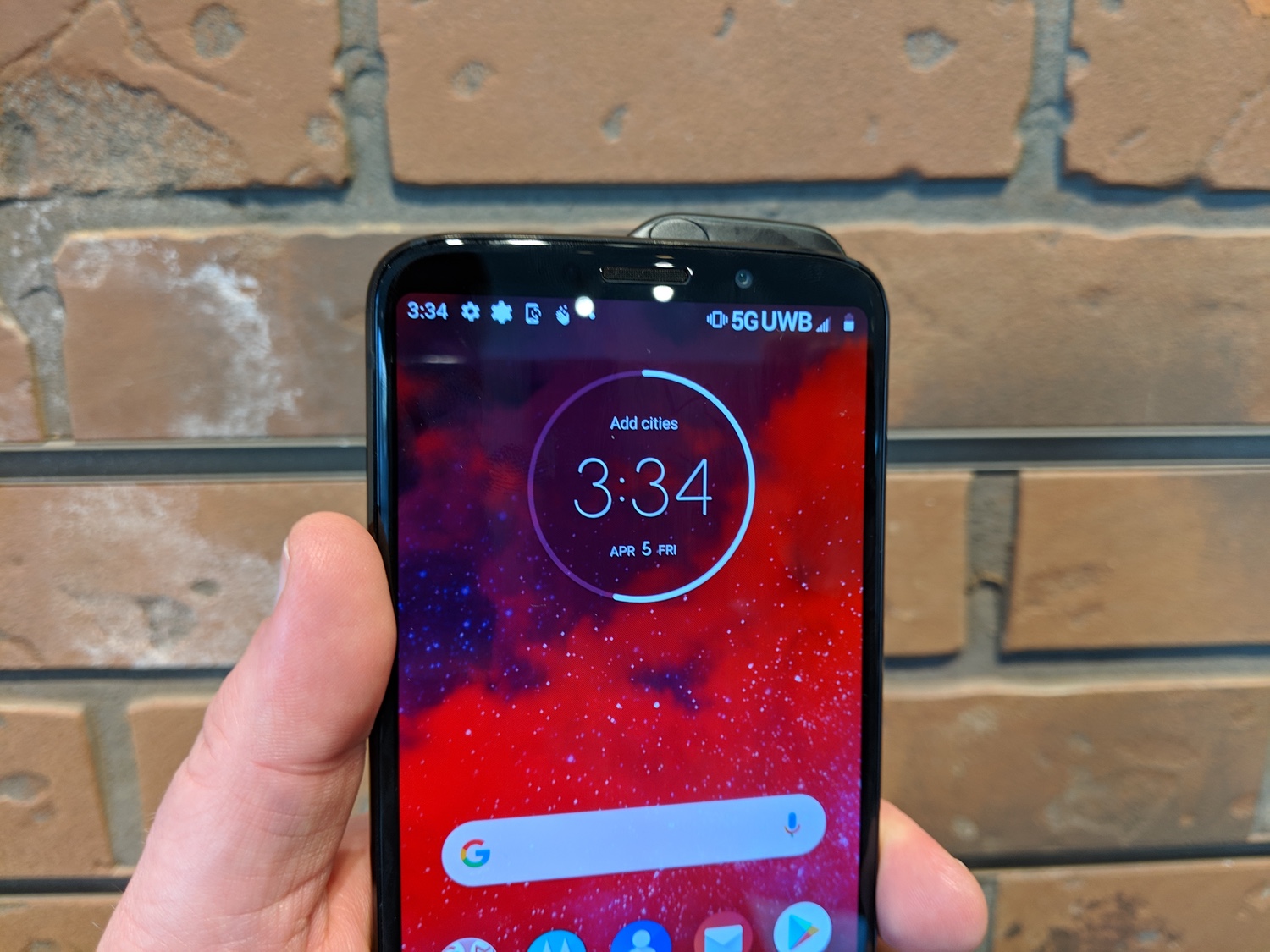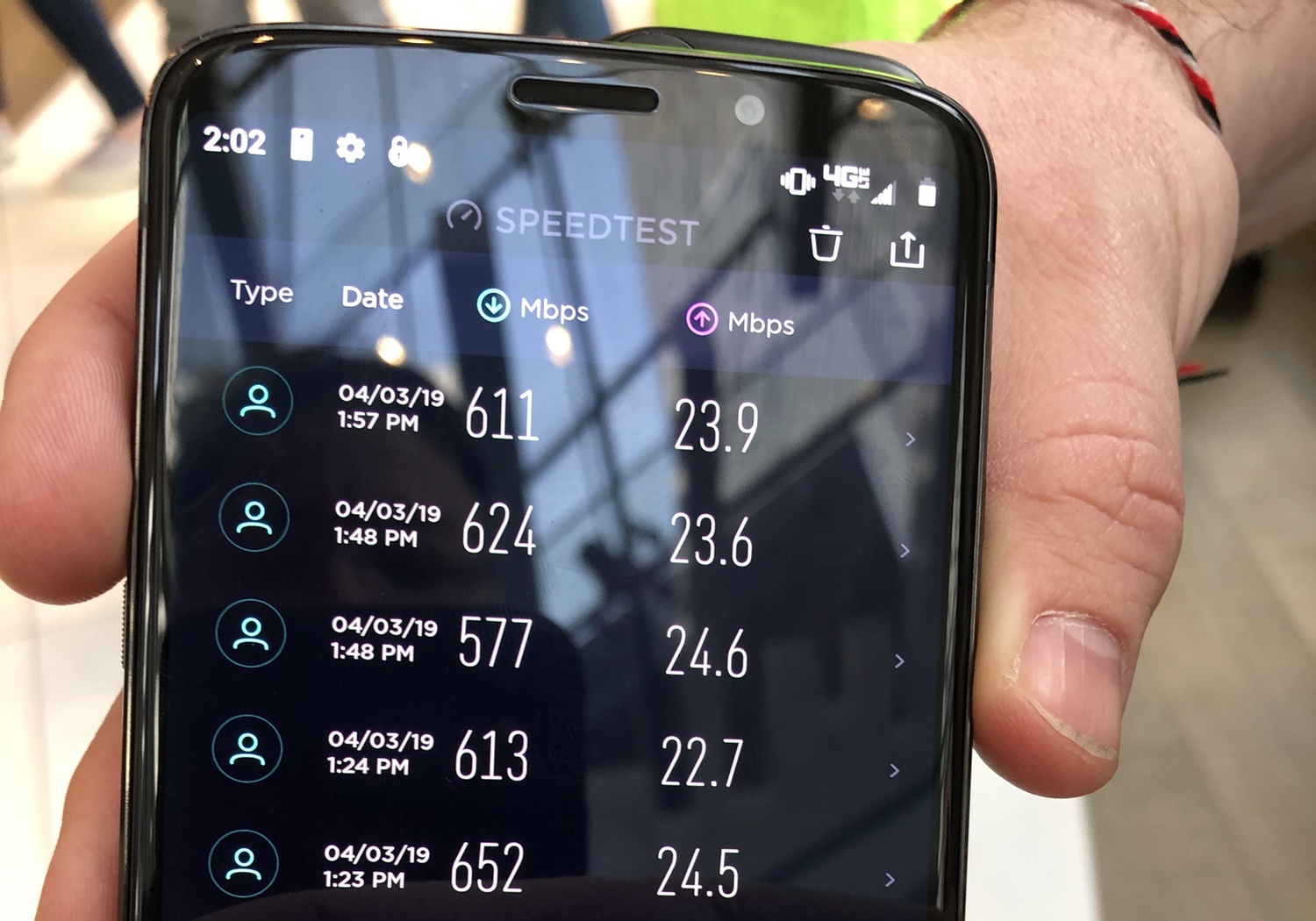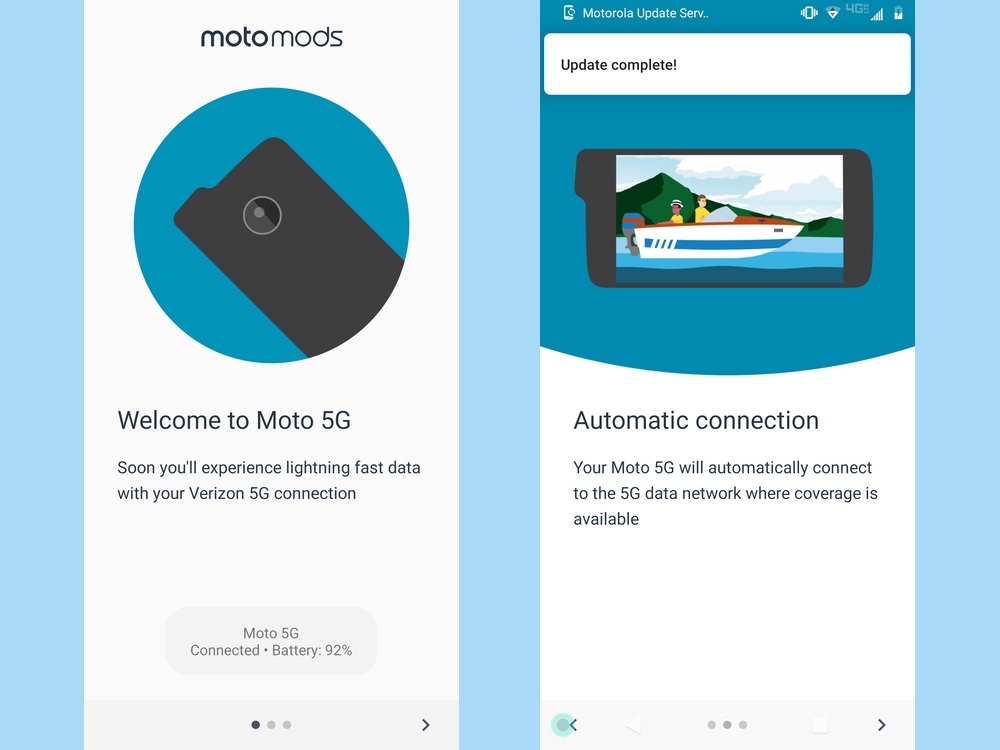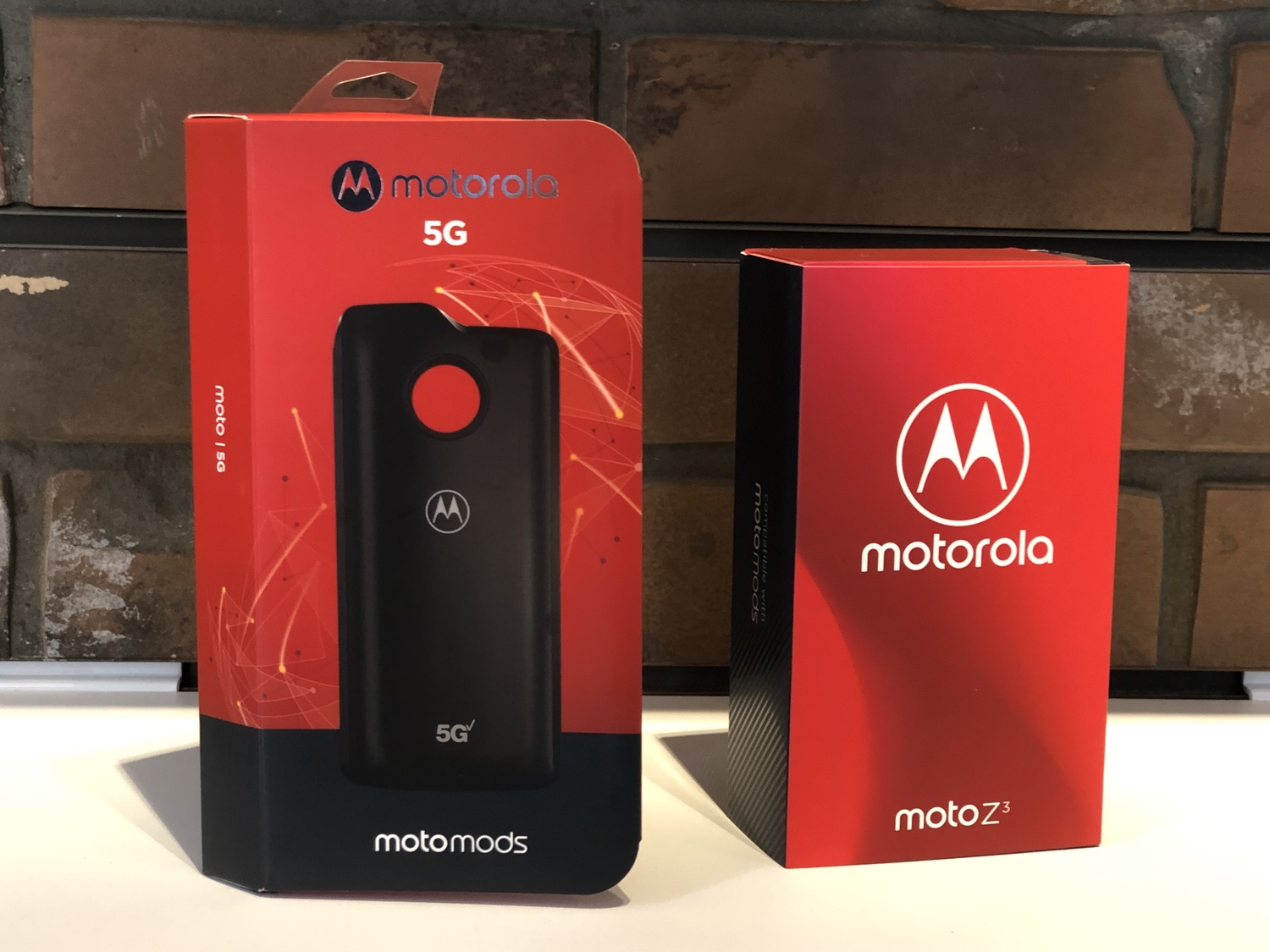First Verizon 5G Speed Tests: Fast But Frustrating
Verizon’s new mobile 5G network delivered speeds in excess of 600 Mbps at the carrier’s launch event in Chicago, but plenty of questions remain.
CHICAGO — The launch of 5G networks means faster data speeds for phones capable of connecting to the next generation wireless network. And now that commercial 5G has arrived— at least in parts of Chicago and Minneapolis if you happen to be a Verizon customer — it's natural to wonder just how fast those speeds are actually going to be.

Pretty fast, as it turns out. But only when you get a signal — something that proved to be a challenge when we spent a day testing Verizon’s newly launched 5G network in Chicago.
5G phones are few and far between at this point, so in our tests, we used a Moto Z3, a smartphone that's been out since last summer, augmented with a newly available 5G Moto Mod. Attach that accessory to the back of Moto’s phone — it snaps right with ease — and your phone is now capable of connecting to Verizon’s 5G network.
How the Moto Mod works
Naturally we were eager to see this kind of performance for ourselves, so we bought a Moto Z3 and a 5G Moto Mod. (The accessory sells for $349, but we managed to get it for $199.) Having freshly burned that hole in our wallet, we were ready to hit the streets — though our out-of-the-box Z3 first needed to be upgraded to Android 9 Pie to work with the Moto Mod.
Like other Moto Mods, the 5G accessory snaps on easily to the back of the Moto Z3. It adds some weight to the phone: Without the 5G Moto Mod, the Z3 is a barely-there 5.73 ounces. The 5G Moto Mod adds another 4.5 ounces to the phone, and since it measures 6.3 x 2.9 x 0.28 in its own right, it increases the bulk of your otherwise svelte Z3 quite considerably.
Attach the 5G Mod to the Z3, and a message flashes across the screen that the accessory is starting up. (You’ll also get a notification as to how charge the 5G Moto Mod’s 2,000 mAh battery is.) And the 4G LTE notification in the upper right corner of the screen will convert to a very visible 5G UWB logo — if you happen to be in an area where 5G is turned on, which proved a little more challenging than we had hoped in our Chicago adventure.
Get instant access to breaking news, the hottest reviews, great deals and helpful tips.
What kind of speeds 5G delivers
Some good news before we dwell on some of the shortcomings with this fledgling network — 5G is fast.
- More: Use the best fast VPN to match your mega 5G speeds

Once we got our Z3 updated, we were able to score some of the same speeds Verizon demonstrated at its 5G launch event this week. In the lobby of the Verizon store, we saw download speeds between 575 Mbps and 579 Mbps with the help of the 5G Moto Mod. Once we removed that accessory, speeds dropped to 35 Mbps to 49 Mbps.
Outside the comforts of the Verizon Store, the speeds of 5G weren’t as jaw-dropping though still pretty fast. Our top speed came at the corner of Wells and Ontario streets in the heart of Chicago’s River North district, where we recorded download speeds of 604 Mbps. More typically, though, speeds ranged between 177 Mbps and 468 Mbps.
Those 5G speeds were improvements over the LTE speeds we saw around Chicago — but the gap wasn’t as big as you might think. Even at Wells and Ontario, where 5G download speeds were hitting 329 Mbps when not hitting the lofty heights of 600 Mbps-plus, our Z3 performed well on Verizon’s network with the 5G Moto Mod removed. There, the phone regularly saw LTE download speeds of 250 Mbps.
It was a similar story outside the Art Institute of Chicago on Michigan Avenue. With the 5G Moto Mod attached, download speeds fluctuated between 367 and 468 Mbps; with the mod removed, our LTE speeds ranged between 163 and 204 Mbps.
The gap was most narrow outside the Merchandise Mart, which not coincidentally houses Motorola’s Chicago office. LTE speeds were a fairly consistent 220 to 231 Mbps. We got faster speeds with 5G Moto Mod attached to the Z3, but not by much — speeds peaked at 367 Mbps. And sometimes, our tests recorded slower 5G speeds than what we got over LTE, something we attribute to the phone switching back and forth between the two networks (more on that below).
Downloading apps and videos
Speed tests are one thing, but what will 5G mean in terms of real-world usage? For example, Verizon tells us you’ll be able to instantly download Spotify tracks and Netflix shows over the advanced network. And you would figure that hefty downloads would be no sweat at all for 5G.
On the Netflix front, at least, 5G proved to be worth its weight. Outside the Merchandise Mart, we were able to download a 152MB episode of Nailed It from Netflix in 43 seconds over 5G. A slightly larger 158MB took an excruciating 13 minutes, 30 seconds over LTE, and we don’t think the extra 6MB was to blame. 5G excelled at this task.
App downloads provided more puzzling results. We tried downloading PUBG Mobile, a 1.81GB file that Google Play begs you to download over Wi-Fi so as not to consume too much of your cellular data. We could download the app over 5G, but it took some time — 5 minutes, 35 seconds inside the Verizon store, 5:31 outside the Merchandise Mart and 6:03 at Ontario and Wells. Shockingly, 4G download times for PUBG were all faster in those locations — 2:54 at Ontario and Wells and 3:01 outside the Merchandise Mart.
A test by Crown Fountain in Millennium Park proved illustrative. We had such a hard time maintaining our 5G connection there, that the PUBG download fizzled, stalling out at 10 percent downloaded after 2 minutes. Once we removed the Moto Mod and tried again, the app downloaded over LTE in a relatively zippy 2:56.
5G Coverage: Hard to come by (for now)
That illustrates one of the biggest problems with 5G at the moment: Even though the network is live in Chicago, it’s got a very limited reach. (The same is also true in Minneapolis, where Verizon also flipped the switch on its new network.) In the Windy City, for example, 5G connectivity is concentrated around the West Loop and the South Loop, according to Verizon. Besides Verizon's own store on the Magnificent Mile, you'll also see 5G coverage in Gold Coast, Old Town and North River, Verizon says.

Walking around Chicago, we saw how fleeting 5G connectivity can be. It’s roughly a third of a mile from the Verizon Store on the Magnificent Mile to the CTA station at State and Chicago. Once we left the store, we never saw the 5G UWB logo flash up on our phone.
Some of the test sites where we had the most stable 5G connections proved how fleeting 5G connectivity can be at this point in its development. Standing on the steps of the Merchandise Mart, we enjoyed a fairly stable connection. But when we walked 13 paces to a sign with the Motorola logo, the logo on our phone fluctuated between LTE and 5G. By the time we crossed the street to the front of the Kenzie Chophouse, the 5G signal was gone.
It was a similar story at Ontario and Wells. Right outside of Al’s Beef, 5G connectivity was fleeting. It was stronger across the street though, with the signal becoming more consistent in the middle of the crosswalk. (We do not advise standing in the middle of Ontario Street to test 5G networks.)
Verizon is using mmWave technology for its 5G network which depends heavily on line of sight. Coverage figures to improve over time, as Verizon builds out its 5G network in this city and elsewhere — the carrier plans to launch 5G in 30 cities by the end of 2019. But if you’re expecting ubiquitous 5G coverage at this point, you’re going to be disappointed, something Verizon itself would readily acknowledge.
5G battery life
5G connectivity isn’t persistent enough at this point to where we could run our Tom’s Guide battery test, which involves continuous surfing over cellular networks until a fully charged phone runs out of juice. (There’s a lot we’re prepared to do in the name of science, but standing on a Chicago street corner for hours on end while a phone’s battery drains is not one of them.) We can share some anecdotal observations after a day of testing, though.

The 5G Moto Mod has its own 2,000 mAh battery, which it seems to draw on when in us, as that battery was draining much faster than the 3,000 mAh power pack on the Moto Z3. At one point during our tour of Chicago, we noted that the Moto Z3 battery was at 69% while the 5G Moto Mod battery was at 59%. After two more test stops that included running Ookla’s Speedtest.net app and trying to download PUBG Mobile, the Moto Z3’s battery had dipped to 59%, while the 5G Moto Mod was at 46%.
Other phones are likely to perform differently, especially with 5G modems built in instead of featured in a separate attachment with its own battery. The upcoming Galaxy S10 5G, for example, will sport a 4,500 mAh power pack, suggesting that phone makers want to make sure surfing 5G’s faster networks won’t drain your phone’s battery just as quickly.
What you can do with 5G (that you couldn't do with 4G)
4G users have grown accustomed to all sorts of limitations, including throttling, video streaming capped at 720p. Verizon told us that you should be able to stream up to 4K. We watched a bit of Avengers: Infinity War over Netflix on a Chicago street corner — not an ideal viewing experience! —and though the picture looked a little sharper over 5G, it’s not something that was truly noticeably on the Z3’s 6-inch screen. (It’s worth noting our LTE unlimited plan with Verizon caps video streams at 480p.)
Verizon also claims that the 5G is truly unlimited, so there should be no data caps. (On unlimited LTE plans, if you go over a certain amount of data, carriers reserve the right to slow your speeds.)We certainly haven’t noticed any throttling during our tests, and we’ve really put the spurs to Verizon’s network.
Will the speeds hold up?
The 5G speeds we’ve seen around Chicago —when we’ve seen 5G speeds — could be slightly inflated. After all, there weren't a lot of other phones connected to the network to slow things down. But then again, 5G is being designed to handle more traffic from more devices so it's possible we won't see the kind of bottlenecks that can happen on congested LTE networks. (LTE speeds are also expected to improve as more devices connect to 5G and free up bandwidth for the remain 4G phones.)
"The beauty of this 5G network is that what we've got is incredible bandwidth in the millimeter wave," said Ronan Dunne, president of Verizon's consumer division during last week’s 5G launch event. "That allows us to deliver all of the potential of 5G: Massive capacity, including burst capacity. Throughput speeds [are] incredible. The ability to support ten times the number of devices in a location. Massive improvement in battery life because of the efficiency. Huge increase in reliability. And essentially, when you put all those pieces together, what you create is a premium 5G experience that's going to deliver the sort of connectivity that people will build new capabilities on."
What you'll pay for 5G
Verizon has announced what you'll pay for those faster speeds. An unlimited 5G data plan costs $10 a month, but that's on top of whatever other unlimited data plan you have with the carrier. (Unlimited plans start at $75 a month with Verizon, so you're looking at $85 a month at a minimum.)
Overall Impressions
There’s a lot of promise for 5G — and at this point, a lot of frustrations. We’d guess that Verizon would be the first to concede that there’s a lot of work ahead, not just in cities still waiting for 5G, but here in Chicago where the network is just getting started.
For that reason, it’s still too early to reach any sweeping conclusions on how big a game-changer 5G networks will be. We’re seeing hints of faster speeds and snappier downloads, but the network isn’t far reaching enough at this point to have much of an impact on the few people who have 5G-capable devices. (And that’s just one device as of this writing.)
The switch may be flipped on 5G ins some areas. But we’ve got a ways to go before this next-generation network is truly ready for prime time.
Image Credits: Tom's Guide
Philip Michaels is a Managing Editor at Tom's Guide. He's been covering personal technology since 1999 and was in the building when Steve Jobs showed off the iPhone for the first time. He's been evaluating smartphones since that first iPhone debuted in 2007, and he's been following phone carriers and smartphone plans since 2015. He has strong opinions about Apple, the Oakland Athletics, old movies and proper butchery techniques. Follow him at @PhilipMichaels.

